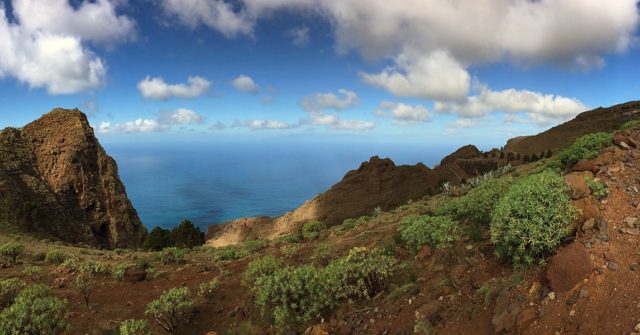I was on holiday recently at La Gomera and discovered that it's quite a fascinating place. This little Spanish island has some pretty awesome surprises in store for you! Here are 5 facts about La Gomera I found very interesting and, I believe, so will you.
It's an ancient volcanic island
La Gomera is a small volcanic rock formation in the Atlantic Ocean, with a diameter of only 22km. Yet its highest peak, Alto de Garajonay, protrudes out of the island some 1500 metres above sea level.
La Gomera feels like a place that time forgot. The population density is only 59 people per square kilometer and you can drive from deep ravines and sleepy mountains down to abandoned villages and deserted rocky beaches without seeing almost anyone or encountering a single traffic light.
The Garajonay National Park on La Gomera protects the island's rainforest and is a UNESCO World Heritage site. Thanks to the volcanic past of La Gomera, you will discover and be awed by the many faces and climates the island offers.
It's actually in Africa
La Gomera is part of the Spanish Canary Islands and is the second smallest of the seven. Despite belonging to Spain, they're actually located near Morocco, off the coast of Africa.
The Spanish conquest of La Gomera began in 1404 and was met with fierce resistance by the inhabitants. The last of the tribes wasn't subdued until 1489.
The conquest was finalised at the summit and centre of the island that had served as the sanctuary of Orahan, the God worshipped on the island and where many of the natives took refuge before defeat by the Spanish.
But scientists studied the inhabitants of La Gomera and found that the Northwest African genetic footprint of the aboriginal peoples of the Canary Islands still persists to this day.
The world's last whistling language
The Guanches, who were the original peoples of La Gomera, had an ancient language of whistled speech, called Silbo Gomero. This whistling language was used to communicate across the steep ravines of the island and it could be heard more than 2 miles away.
The existence of the language has been recorded since the Roman times. In the 16th century, the Spaniard settlers adopted Silbo Gomero. Thanks to this, the language survived the assimilation of the Guanche people who today are no longer with us.
Today, the local government requires all children to learn the language in school to continue the existence of the language into the future. I suggest asking a local to teach you how to whistle a few phrases yourself!
Christopher Columbus and the New World
With the support of the Spanish Crown, Christopher Columbus, or Cristobal Colon as he is known to the Spanish, made his voyage to the Americas in 1492, forever changing our understanding of our planet.
The last port of call across the Atlantic Ocean happened to be the port of La Gomera, just 3 years after the last aboriginal tribes surrendered to the Spanish.
Although he planned to replenish food and water supplies for only a few days, his trip was extended to a month after arrival. The reason for this was the widowed Countess of La Gomera, Beatriz de Bobadilla Y Ossorio, who offered him vital support in preparation. In reality, it is said it was the beauty of the bored countess that postponed the dashing young adventurer' trip.
It was not the last time the two met either. In 1943 and 1498, Columbus had another two voyages to the Americas which both set sail from La Gomera. Casa de Colon, the house reputed to have been the place where Columbus stayed, is a tourist attraction now. I recommend a trip there to see the permanent exhibition of pre-Columbian sculptures they have on display.
Where man met God
A quirky hidden treasure on the island can be found near an abandoned village named Gerian. It's a tiny chapel perched on the edge of a cliff at a dizzying height of 950 metres. Built in 1962 by a farmer called Don Candido Dorta, as I was told by a local friend, it has a story of small wonder behind it.
Namely, the farmer's cow was very sick. Not wanting his livestock to die, he promised God that, if the cow survived its illness, he would build a place of worship for God. The animal got better and so the farmer built the chapel as a thank you to God for saving his animal friend. Now, the locals hold a fiesta in the chapel every year in October, keeping the story alive – you're welcome to check it out.










1 comment
And how should those be “AMAZING FACTS ABOUT LA GOMERA YOU DID NOT KNOW ABOUT”?
Those are absolutely amazing to know things!
How great!